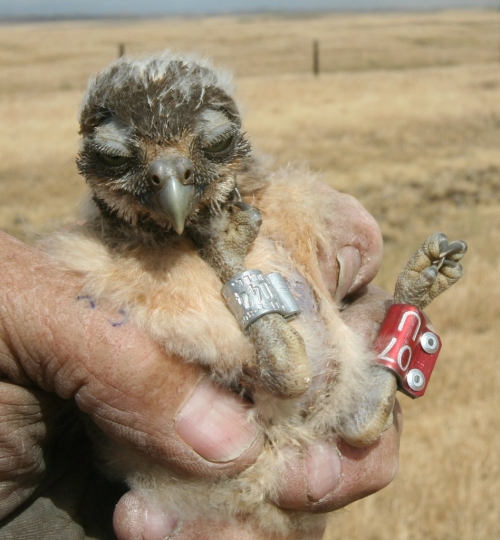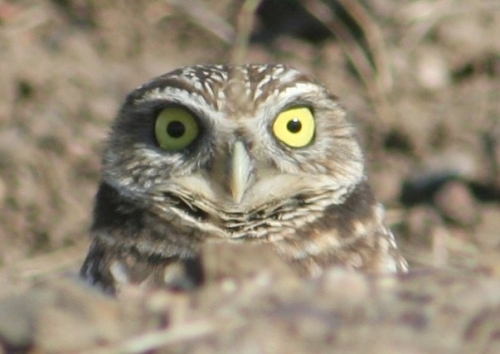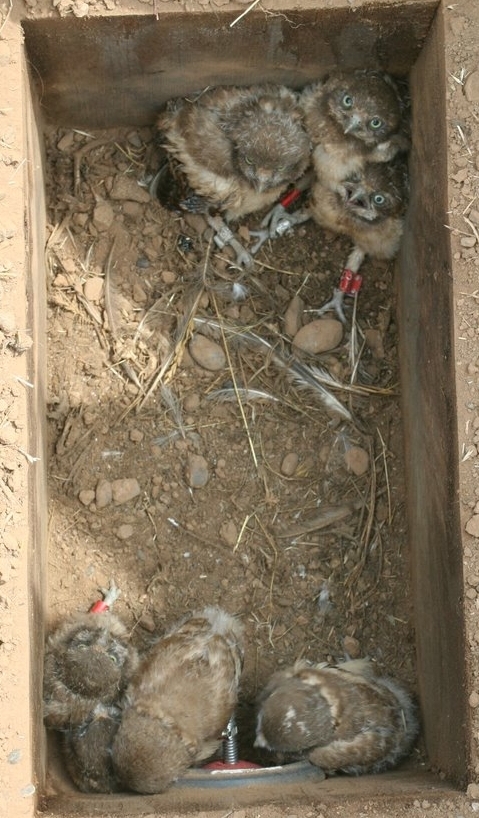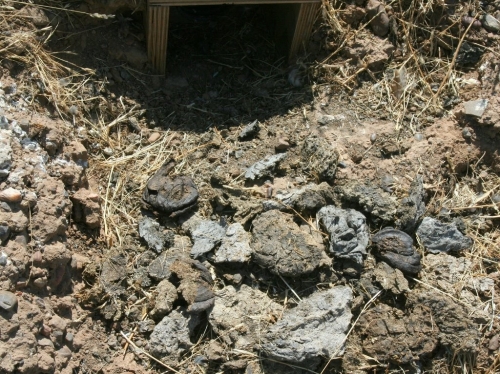 Is This One Of The Cutest Chicks You Have Ever Seen?
Is This One Of The Cutest Chicks You Have Ever Seen?
Just look at those “eyelashes”
This Burrowing Owl chick that my friend Steve is holding here has been banded with two different bands. The one on the right leg is a #4 federal leg band and the one on the left is a red anodized auxiliary marker used to identify individual birds form a distance.
Bird banding is a universal and indispensable technique for studying the movement, survival and behavior of birds. Wild birds are captured and marked with a uniquely numbered band or ring placed on the leg. The bander records where and when each bird is banded, how old it is, what sex it is, and any other information and sends those data to the Bird Banding Laboratory.
Information from bands subsequently found and reported to the Bird Banding Laboratory provides data on the distribution and movements of species, their relative numbers, annual production, life-span and causes of death. This information increases our knowledge and understanding of birds and their habits and assists us in their management and conservation.
For more information on bird banding go to the Patuxent Wildlife Research Center. In the meantime, here is a short Burrowing Owl video
And a photo of the male Burrowing Owl 
 Banded Burrowing Owl Chicks In The Nest Box
Banded Burrowing Owl Chicks In The Nest Box
Artificial nest boxes are being used to bring burrowing owls back from their declining numbers in California, with the help of the California Burrowing Owl Consortium. This is a wooden nest box Steve built out of 1 1/8″ thick plywood. It measures 24″ L x 11″ W x 12″ H and is buried with 12″ of soil covering the box. An 8 foot piece of 4″ corrugated plastic pipe, with a 90 degree bend, is used as the tunnel to the surface. See my burrowing owl nest box plan using an irrigation valve box here.
 Burrowing Owl Nest Entrance Complete With Cow Dung
Burrowing Owl Nest Entrance Complete With Cow Dung
This photo shows the burrow entrance with cow dung placed strategically by the owls to attract one of their favorite foods, the dung beetle. It was first believed that this was done to help mask the smell of the young down in the burrow to detour predators from smelling them, but studies have shown that this is a technique the owls have learned to use to attract the dung beetles to them.
Steve places the burrows in blocks of four, about 75 yards apart. He was able to band 12 young burrowing owls last year and we are all hoping for these numbers to increase in the future.
I am working on a proposal with the Audubon Society to place nesting boxes for the burrowing owl here in the Redding area of northern California. I’m not sure if we will be able to do anything in time for this years breeding season but we hope to have several nesting sites operational by next year.









Comments on this entry are closed.
That is so cute and I loved the video too. It’s nice when people like you try to do something to help.
That chick is adorable! And 7 chicks in one next box? Amazing.
Do What You Loves last blog post..Felting Photo Shoot
@Ramblingwoods thank you for your kind words
@Stacey thank you for checking out my birds!
Those chicks do indeed have beautiful eyes and eye lashes. It was interesting to see the the chicks in their nest box from above. It’s good that they have some more options for homes these days.
Natural Momentss last blog post..Blue Grouse Portrait
What you guys are doing is a very noble undertaking. My hat’s off to you!
Bob Ks last blog post.."You know how to pish, don’t you?"
@Bernie thanks for the comment. I do love these little owls
@Bob thanks very much. Keep on pishing!
Fascinating report on burrowing owl conservation, even the part about the dung by the burrow to attract the beetles.
Diane C.s last blog post..I and the Bird: A Blog Carnival
@Diane thank you for the visit and the excellent post on the Cactus Wren. Your photos are wonderful!
Larry,
It takes a special kind of person to band birds. I volunteered with a local bird banding station over the last summer. I met some great people, and learned a lot. I also learned that as much as I wanted to help, I was not cut out for banding because I couldn’t get past feeling like I was invading their lives. Still, I know that the data collected from banding ultimately helps the birds, so I am glad for the volunteers that do this. I recently programmed a TI-82 calculator with the Empidonax formula to help the banders with field ID.
And yes, that chick is about the cutest little chick ever!
Amber Coakleys last blog post..Hey, whaddaya doin’?
@Amber I don’t know if I could do it either. I may be going down to help Steve this spring as a volunteer to help in the banding of Tri-colored Blackbirds. Having never done it, I’m sure it will be an experience to remember if I do.
Those Empids are a tough group ti ID for sure. Is programming something you do for a living?
BTW, I LOVE your new look at your website. It is awesome!
Hi Larry,
Yes, I earn my living as an accountant and a database designer. I am learning “web stuff,” and am getting more comfortable with it. Thanks for the kudos 🙂
I noticed that you had my site on your blogroll! Thanks, and I’ve added yours to mine.
Amber Coakleys last blog post..Hey, whaddaya doin’?
Wow, the eyes on those things are spooky.
They aren’t so cute when the nests get to close together: then you get to see the parent owls enter other nests, kill the young, and begin to tear them apart to feed thier own clutch. Not real cute.
Good morning. We just completed habitat for the Burrowing owls on our farm. Do you have any hints on getting them to move in? 🙂 Thank you
I wish we knew the answer to that question Dru! The best thing to do is to build the artificial burrows in a good location with the proper attributes and hope the birds find it. We (BurrowingOwlConservation.org) have a downloadable PDF file to help your project be more successful. Keep the grass short near the burrow entrances and I like to use dead tree branches for perches but posts do well also. I wish you the best of luck and if there is anything myself or the Burrowing Owl Network can do for you, let me know. Aslo please keep us updated on your progress.